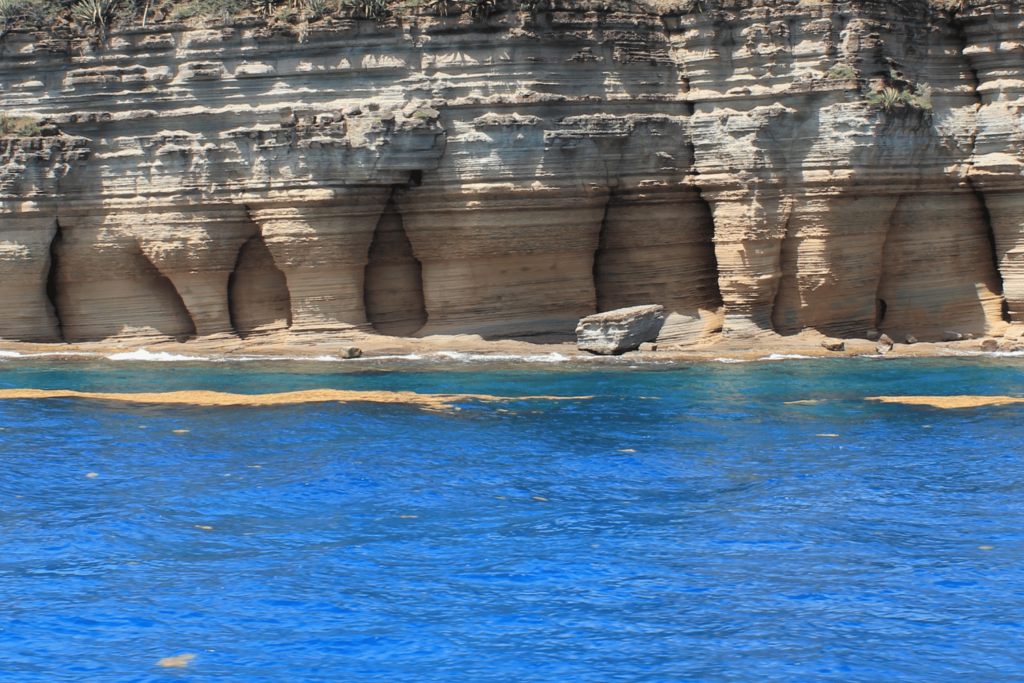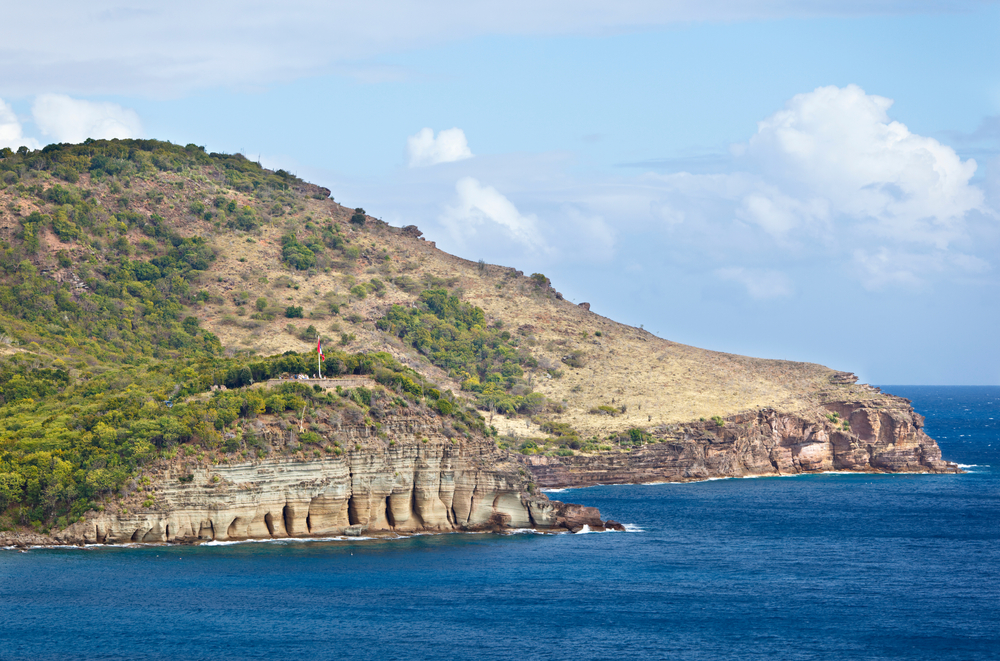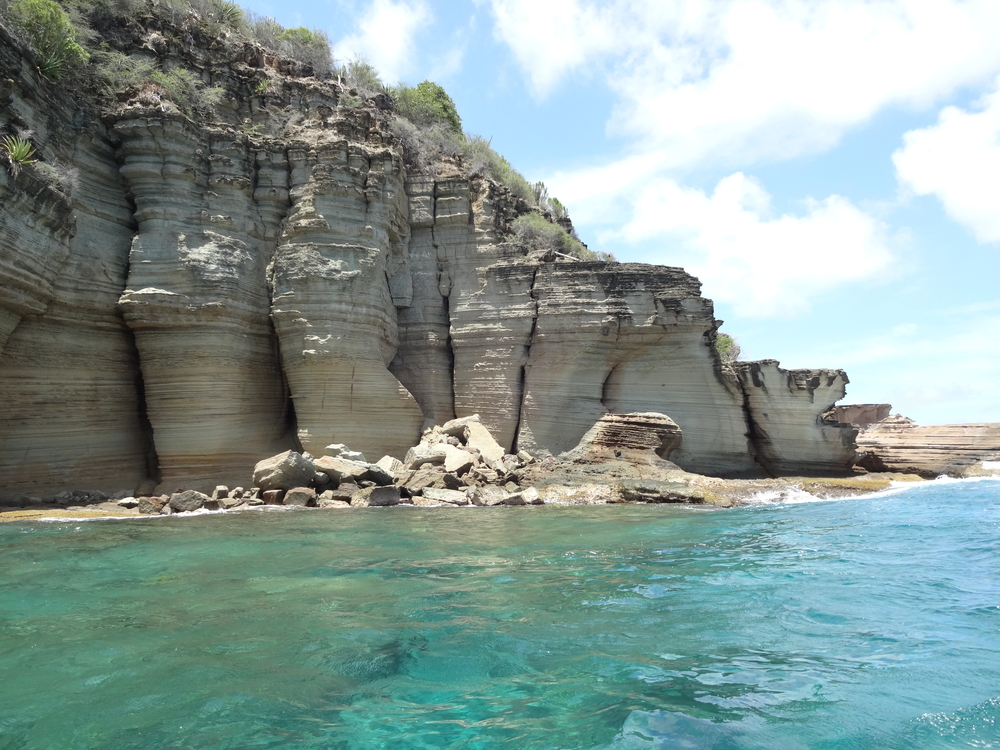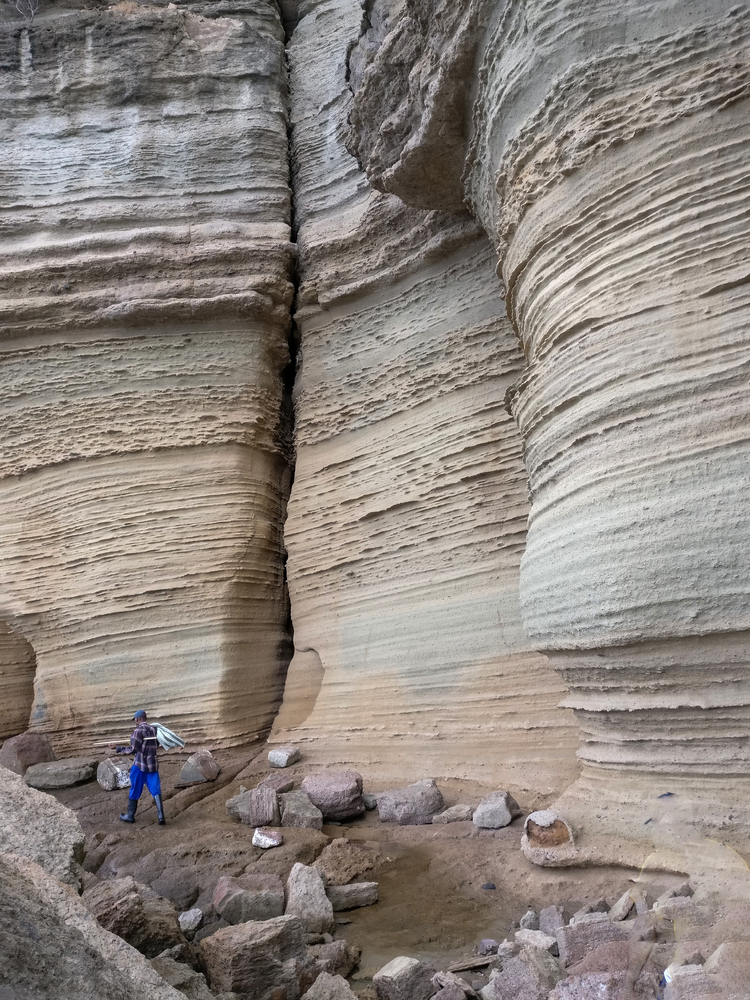Rising high above a hidden part of the coast of Antigua, the Pillars of Hercules are a marvelous limestone formation. With strange horizontal striations, these pillar-shaped rocks are a wonder to behold. More than just some mythical structure, they’re a testament to the passage of time with a long history of leaving humans in wonder.
So, let’s take a closer look at this sea sculpture in Antigua and discuss how the formation occurred from the start.
Where Are the Pillars of Hercules?

Two formations are often called the Pillars of Hercules.
The first is a formation in the Strait of Gibraltar. Sometimes simply called the Rock of Gibraltar, where the ancient Grecian hero supposedly split a mountain to form the strait, shoving them apart and opening a pathway between the Atlantic and the Mediterranean. While an interesting example of geology, it’s not what covering.
Instead, we’re discussing a limestone formation on the southern shore of the island of Antigua, on the English Harbor. Towering above the water, the formation consists of pillar-like formations carved into the cliffside.
While the first formation takes its name directly from mythology, that’s not the case in Antigua. Instead, it appears that the name was simply taken to sound impressive by evoking the image of Hercules himself. It’s easy to see why, while the formation doesn’t look large in wider shots, when you see their size compared to a person at the base they are indeed impressive.
It Starts With the Base

Well, first you need an island. Antigua itself is part of the Caribbeans chain of islands. This volcanic arc is the result of a subduction zone, where one tectonic plate moves under the other. These zones are a common source of volcanic islands.
Specifically, the Caribbean plate moved under the Atlantic plate. The immense pressure of this movement causes heat as well, resulting in the formation of less buoyant magma breaching the surface of the sea floor.
Underneath the sea, this generally forms into igneous rock, most often basalt. The known igneous rock of the island is primarily basaltic and rhyolitic in composition. Basalt is composed of minute crystals of feldspar, while rhyolite is a high-silica form of igneous stones.
The combination of rhyolite and basalt is known as andesite.
Over time, these rocks came from the ocean floor and breached the ocean’s surface. But the Caribbean islands, Antigua included, are older than places like Hawaii so this is only the beginning.
Erosion and Coral

These older islands bear significant amounts of sedimentary stone. In this case, the stone is specifically limestone.
Over geological time periods, the wind and water rip particles from the base rock. Forming sediment. In the case of Antigua, coral reefs also began to form along the island’s edge. This coral forms an important part of the story.
Corals take and fix calcium carbonate from the ocean into their skeletons. The constant action of water means that these spectacular formations constantly take damage, also releasing sediment. Over millions of years, these sediments pile on top of each other, pressing the sediments into a solid mass.
In this case, we have limestone. As time passed, the limestone also emerged over the water’s surface thanks to geological uplift just as much as the build-up of more stone. This has left an island with a unique geology, known as a karst system.
Limestone is a soft, fairly soluble stone, so things like sinkholes and caves are fairly common in areas where limestone has become the dominant rock touching the ocean.
This process formed the island’s cliffs, including those of the Pillars of Hercules.
Formation of the Pillars of Hercules

The story only begins there. The Pillars of Hercules tower over the water’s edge, occurring as irregular spires of limestone at the base of the cliffs. These pillars show deep divots between them and also strong horizontal lines.
The pillars themselves are massive. An exact height measurement isn’t readily available, but it would appear they’re at least twenty feet tall judging by the pictures of people standing next to them. The cliff face rises considerably above the pillars themselves, which can seem small in wider shots of the area.
The formation itself appears to have been created by differential erosion. This occurs when rocks of different hardness form in close patterns, creating areas where the wind and water cut deep in some areas and not as deeply in others.
The rock pillars are deeply cut, forming the larger impression of the formation.
However, another secret lies in this formation’s history.
Normally, when we see rocks with horizontal striations we’re looking at different sediment layers that have been deposited in the area. And this is still true to some extent, the higher portions of the cliff are a different layer, for instance, showing different coloration than the pillars themselves.
But we have another mechanism at play where the pillars themselves stand.
The horizontal lines on the pillars appear to cover different sea levels. These often appear to be chiseled at first glance, and they were. It’s just that the master artisan who crafted this impressive formation turned out to be the sea at different levels, allowing the waves to impact the formation at different heights.
Visiting the Pillars of Hercules
The Pillars of Hercules are a common tourist site, with diving available right off the shore.
It’s accessible by boat, which is the usual method for divers. Here you can see the dramatic coloration of the water, and dive and see the underwater corals whose ancestors gave birth to the limestone of the pillars themselves. The area is lively and filled with interesting corals and fish.
Others prefer to take the steep hike from the nearby Galleon Beach until you round the corner of the crescent-shaped beach for their dramatic forms to appear.
In either case, it’s something you should check out at if you’re in Antigua and interested in geology. Even for those who aren’t rockhounds, however, the towering formations are worth checking out.
- Online rock and mineral club for collectors of all levels!
- Find community with like-minded rock and mineral enthusiasts.
- Monthly Giveaways!
- Free Access to Entire Digital Library of Products (annual memberships)


